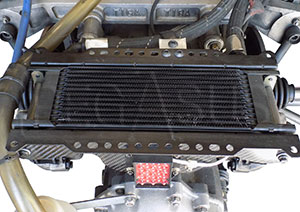How Tight is Right?
| Some experienced mechanics find themselves intimidated by AN plumbing fittings because they seem so different than automotive fittings. But keep in mind that the AN plumbing system was developed for the US military. It was critical to have a system that wouldn't require extensive training before soldiers could start maintaining equipment in the field, in less-than-ideal conditions. |
Background
The magic of the AN plumbing system is the 37° sealing flare.
The first system of flared fittings adopted by the Army Air Corps in the 1930s had a 30 degree flare. Soon the US Air Force and engineers at Wright Patterson Air Force Base refined the system, deciding that the 37 degree angle provided the best combination of sealing and resistance to damage (i.e., reusability). As you tighten the nut, the flare tries to guide the two flares into alignment, like a funnel. But perhaps even more important for us is that the torque required to seal AN fittings is quite low -- and forgiving!
Tightening Method 1: Torque
If your installation lets you use a torque wrench on the fittings, use the values in the table below. Torque values are shown in Pound-Inches (divide by 12 for pound-feet).
| AN Fitting Size | Aluminum Fittings | Steel Fittings |
|---|---|---|
| 3AN | 70-105 | 95-105 |
| 4AN | 100-140 | 135-150 |
| 6AN | 150-195 | 270-300 |
| 8AN | 270-350 | 450-500 |
| 10AN | 360-430 | 650-700 |
| 12AN | 460-550 | 900-1000 |
| 16AN | 700-840 | 1200-1400 |
Note: These torque values are a general guide that covers most fittings. It is not intended to override any manufacturer's specific recommendations.
If you're not sure which size you're dealing with, check our AN Plumbing Fitting and Hose Size Guide.
Tightening Method 2: Counting Flats
In many cases, a torque wrench just isn't a practical solution. Fortunately, the forgiving nature of AN fittings allows a novel approach often referred to as the "Flats Method." Many engineers actually prefer this method over the torque method because it eliminates variables in friction due to material finishes.
Step 1: Assemble the fittings. Screw down the female nut until finger-tight. At this point the seat is making contact. You can double-check by trying to wiggle the tube portion of the female fitting. You should not be able to see any movement. If you see visible movement, try tightening the nut again while wiggling the tube. If the nut won't turn any further by hand, look for the reason why the nut stopped short.
Step 2: Mark the fittings. Using a permanent marker, draw a line on one flat of the hex on the male fitting and a matching line on the female nut (the two lines should line up). This is your reference mark.
Step 3: Tighten the fittings. Using a wrench, tighten the female nut 1/4 turn, or 1.5 hex flats. Check your reference marks to be certain that the nut has been tightened 1/4 turn.
Step 4: Mark the fittings again. Using your permanent marker, make a new reference mark from the female nut to the hex on the male fitting. The original mark, now offset, acts as a visual reference that this connection has been tightened. The new mark is a visual reference that the fitting is still tight. If this second mark becomes misaligned, it means the fitting is coming loose.
Remove the reference marks before re-using the fittings to avoid any confusion. (Brake cleaner is very effective at removing "Sharpie" ink!) This is why we use a marker instead of scribing the marks.
Too Tight and Still Leaking
If you or a well-meaning helper just couldn't control your strength and cranked down too hard on a fitting, you may encounter a persistent leak. Ironically, tightening the fitting further will probably not stop the leak. In this case, overtightening has damaged the fitting.
If you're lucky, the damage will be nothing more than minor scoring on the sealing faces. That type of damage can usually be fixed by adding a SECO 7 Seal (Part No. 3202-Size) and re-torquing properly using one of the methods above. More extensive damage to the male sealing face can be repaired using a Koul Tools Fitting Fixer (Part No. 3330-1xx).
But if you're not so lucky -- if the wrench was in the hands of a truly muscle-bound ogre -- you may be looking at more serious problems. The threads may be damaged or even stripped, or the female fitting may have cracked. In either case, the only fix is to replace the damaged fittings.


